Stay logged in to proceed with bookings, orders and offers.
On changing the terminal, you will loose items in your cart. Are you sure you want to change your terminal?
There’s one thing that had been on my bucket list for the longest time: to see a tiger on a safari. Countless itineraries had died natural deaths before they even began, and I was beginning to give up, when, suddenly, in December the opportunity to take a small break became a possibility.
I decided that come what may, we were going to Ranthambore National Park – the Land of Tigers. I took care of the logistics. However, I left the actual act of spotting a tiger to the benevolence of the Universe. There may be better places to spot tigers other than Ranthambore, such as Bandhavgarh, Kanha, and Tadoba, which rank among the top three most densely populated tiger reserves in the country today. But we chose Ranthambore for several reasons.
The main reason was that we only had four days for the trip, including travel. If we visited Pench or Bandhavgarh, a large chunk of that time would have been spent just getting to and back from our destination. We, of course, wanted to spend more time in the jungle and less time travelling. Ranthambore, with its easy connectivity, was our best option.
The easiest way to reach Ranthambore National Park is to fly to Jaipur. We flew to Jaipur International Airport from Mumbai on a cold December morning. The airport sits just 13 km outside the city and is well-connected via several domestic and international airlines.
A three-hour drive (177 km) from Jaipur Airport takes you to Sawai Madhopur which is a small city adjoining Ranthambore. There are many hotels and lodges in Sawai Madhopur and the main entry gates to the national park also lie within the city. There are also a few attractions in Sawai Madhopur that are worth visiting. The famous Ranthambore Fort, which is a UNESCO World Heritage Site; Trinetra Ganesh Temple; and Galta Temple are some of the places you must visit in the city. However, with the restricted amount of time at our disposal, we could not visit any of these places. So, we created a schedule that focussed on spotting just the fantastic beast.
Ranthambore National Park is spread across an area of around 1500 sq km. There are 10 zones in the park and several entry gates. The largest concentration of the park’s tiger population is between Zones 1 to 5. Zones 6 to 10 are further away from the main tourist hotels and are mostly visited by locals. Keep in mind that this only increases your chances of spotting a tiger but does not necessarily guarantee it. Only an experienced guide and driver will be able to pinpoint a tiger’s movement.
Since we'd planned the trip at the last minute, it was difficult to find a room. All the presumably big and fancy hotels were unavailable. This was not surprising given that we were travelling around New Year's eve and most hotels tend to be packed around that time. A desultory search for boutique hotels in Sawai Madhopur threw up an intriguing lifeline. Fateh’s Retreat in Ranthambore is a homestay with a proud history. It is at once a working farm, a cafe, a homestay, and a museum to the late great Fateh Singh Rathore aka The Tiger Man of India. Fateh Singh Rathore is often attributed as the hero responsible for Ranthambore National Park. Perched on a cliff, overlooking the Aravali Hills, the homestay has a beautiful infinity pool that looks over a forest. The family members still live in this house and serve delectable home-cooked food to their guests.
The only thing that Fateh's Resort could not help me with was booking my safari, largely because I booked it too late. I was left to my own devices when it came to booking our safari. And what an adventure that turned out to be!
Several websites promise immediate and speedy help with booking a safari in Ranthambore. Many of these sound and look official enough and take visitors through a variety of payment packages. But, the moment you fill in the form online, you will be inundated with calls urging you to pay up immediately to not lose your place. That was the first red flag for me. I decided to dig deeper and found out that even though these sites looked credible, they were just glorified tourism portals out for a quick buck. There is only one official site to book your permits and that is the official website of the forest department of Rajasthan.
We managed to snag the last three seats in a jeep safari for one day and a canter for the other. Jeeps seat 6 people while centers are open-air buses that can seat up to 22. Both are very reasonably priced, so if you receive safari quotations for INR 6,000 or INR 20,000 (like we did), please know that you are being cheated. It is recommended that you squeeze in at least two to three safaris during your time in Ranthambore. This will considerably increase your chances of sighting a tiger.
Safaris in Ranthambore operate twice a day, with each safari lasting for up to three hours. Safari timings alter as per the season but, as a rule, the last jeep or canter has to leave the park before sunset. Since we travelled in December, the morning safari was between 7:00 to 10:30 am and, later, between 2:30 and 6.00 pm.
If you book your slot independently, you should ideally reach the gate half an hour before departure. However, our hosts at Fateh's Resort were very kind to arrange for the forest guide to pick us up en route for a small extra fee. Make sure you carry the ID card you used for booking the safari. Other essentials include water and a scarf to wrap around your nose and mouth. The terrain is rocky and dusty and the open-air vehicles barely offer any protection. Morning safaris can also be very cold, so bundle up and keep your ears and hands covered.
We started our first safari at 2:15 pm from Gate no. 5. It was incredibly exciting in the canter and we even managed to spot many deer and even a crocodile right off the bat. However, the tigers remained elusive even as the hours passed. We were seated just behind the driver and the guide, and their keen attention to every sound that came from the jungle was impressive. A monkey’s call was a signal of distress or warning. A deer darting across our path indicated that danger was near. Birds chattering and flying off suddenly could only mean one thing – the king of the jungle was near. We picked up a faint trail and veered off course but after several minutes of waiting, it was evident that we were not going to be lucky that day.
Just when we had dejectedly made peace with the fact that it was not going to be our day, the driver noticed a group of vehicles ahead. Just a few metres away from the exit gate! He stepped on the gas and suddenly our canter found itself amidst several others. And there he was: the tiger we had all been hoping to see! What a stunning giant – it's orange stripes undulated menacingly between the tall grass. There was even a moment when my heart stopped as he turned and looked in our direction. We followed him as he made his way down a river until we couldn't spot him any longer. I finally understood the lure of a safari. The adrenaline rush that comes from seeing a wild animal in its natural habitat is incredible. After a three-hour long ride through bumpy terrain and dusty cold wind, we were rewarded – and how. Ticked that one off my list. Now, please excuse me while I book another exciting safari!





The Adani One expressly disclaims all liability, direct and indirect, in respect to actions taken or not taken based on any or all the contents of this Blog. The Blog is an opinion of the contributor based on the collation of data from various sources and is provided only for information purpose. Adani One does not canvass, advertise, solicit, invite or induct for any product, merchandise, information, brand or any other materials mentioned in the Blog, nor does it obtain any monetary benefit from the same. Reader is advised to read and apply his/her intellect and discretion in this regard. Any Intellectual Property mentioned in this blog belongs to the rightful owner. We do not intent to claim any interest over the same.